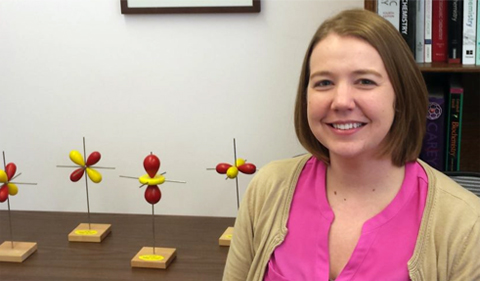
Dr. Jessica White
Dr. Jessica White, Assistant Professor of Chemistry & Biochemistry, gave an invited talk titled “Photoactivated Ru(II), Mn(I) Bimetallic Complexes for CO Release and Singlet Oxygen Production” at the 28th Inter-American Photochemical Society winter meeting Jan. 2-5 in Sarasota, Fla.
“The IAPS has been established to promote and disseminate knowledge, and encourage development, of photochemistry and allied subjects throughout the Americas…The scope encompasses the numerous areas related to the interdisciplinary nature of photochemistry, e.g. theoretical, photophysics, photobiochemistry, photobiology, etc.” according to the IAPS website.
Abstract: The rich and tunable visible light photoreactivity of Ru(II) and Mn(I) complexes offers exciting opportunities for the development of less invasive and spatiotemporally controlled treatment of cancers and other diseases. Ru(II)-diimine are known to produce singlet oxygen with moderate-to high quantum yield under visible light, a feature that makes this class of compounds promising as anti-cancer agents through oxidative damage of biomolecules only with a light stimulus. Strategies for the photoactivated release of CO ligands from Mn(I) complexes using light were developed with a class of compounds called photoCORMS (photoactivated CO releasing molecules). CO is pro-apoptotic and anti-proliferative toward cancer cells at high concentrations, so providing a method to control its delivery is desirable for anti-cancer treatment. Our lab currently focuses on the design, synthesis, and photochemistry of new diimine-bridged Ru(II),Mn(I) bimetallic complexes that release multiple CO ligands and a singlet oxygen-generating photosensitizer from a single molecule when irradiated with low energy visible light. The new molecular architecture is designed to provide a platform for probing the impact of codelivering CO and singlet oxygen with spatiotemporal control. The design, synthesis, and investigation of electronic properties of the new diimine bridged Ru(II),Mn(I) complexes as well as the ligand exchange photochemistry that occurs upon excited state population and the factors dictating the efficiency will be presented.



















Comments